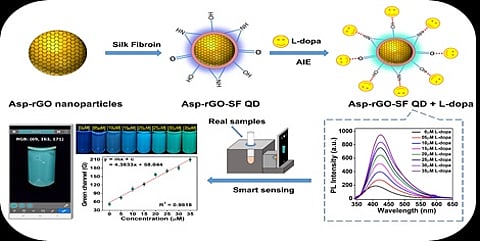

Scientists have recently developed an affordable, user-friendly, and portable smartphone-based fluorescence turn-on sensor system that can significantly aid in the management of Parkinson's disease. This innovative sensor is designed to accurately detect the concentration of L-dopa in the body, enabling precise dosage adjustments essential for effective disease control.
Parkinson's disease is characterized by a continuous decline in neuron cells, leading to a substantial reduction in dopamine levels, a critical neurotransmitter. L-dopa, a chemical that is converted into dopamine within the body, serves as a key treatment for Parkinson's, helping to mitigate dopamine deficiency. The disease can be managed effectively with the correct dosage of L-dopa; however, as the disease progresses and more neurons are lost, patients require higher doses of L-dopa. Administering too much L-dopa can lead to severe side effects such as dyskinesia, gastritis, psychosis, paranoia, and orthostatic hypotension, while insufficient doses can cause the reemergence of Parkinson's symptoms.
Given the crucial role of maintaining optimal L-dopa levels in treatment, it is essential to have a simple, cost-effective, sensitive, and rapid method for monitoring L-dopa in biological fluids. To address this need, researchers at the Institute of Advanced Study in Science and Technology (IASST), an autonomous institute under the Department of Science and Technology, have developed a smartphone-based optical sensor system. This system utilizes a fluorescence turn-on mechanism to instantly detect low levels of L-dopa in biological samples.
The sensor is constructed by coating a silk-fibroin protein nano-layer, derived from Bombyx mori silk cocoons, onto reduced graphene oxide nanoparticles. This combination forms core-shell graphene-based quantum dots with excellent photoluminescence properties, making it an effective fluorescent turn-on sensor probe. It can detect L-dopa in real samples such as blood plasma, sweat, and urine within a linear range of 5 μM to 35 μM, with detection limits of 95.14 nM, 93.81 nM, and 104.04 nM, respectively.
The researchers have also designed a smartphone-based electronic device featuring an electric circuit connected to a 365nm LED powered by a 5V smartphone charger. The setup is enclosed in a dark chamber to prevent external light interference. During the sensing process, the sensor probe is illuminated with the 365nm LED, and the resulting color changes are captured by a smartphone camera. The RGB values from these images are then used to assess L-dopa concentration through a mobile app.
This simple, cost-effective, and rapid screening tool is especially valuable for on-the-spot analyte detection in remote areas where advanced equipment is unavailable. By enabling the detection of low L-dopa levels in biological samples, this sensor system could play a critical role in adjusting medication dosages, ensuring more effective control of Parkinson's disease.
Reference:
1. Singh, Neha, Viness Pillay, and Yahya E Choonara. “Advances in the treatment of Parkinson’s disease.” Progress in Neurobiology 81, no. 1 (January 1, 2007): 29–44. https://doi.org/10.1016/j.pneurobio.2006.11.009.
(Input from various sources)
(Rehash/Ankur Deka/MSM)
